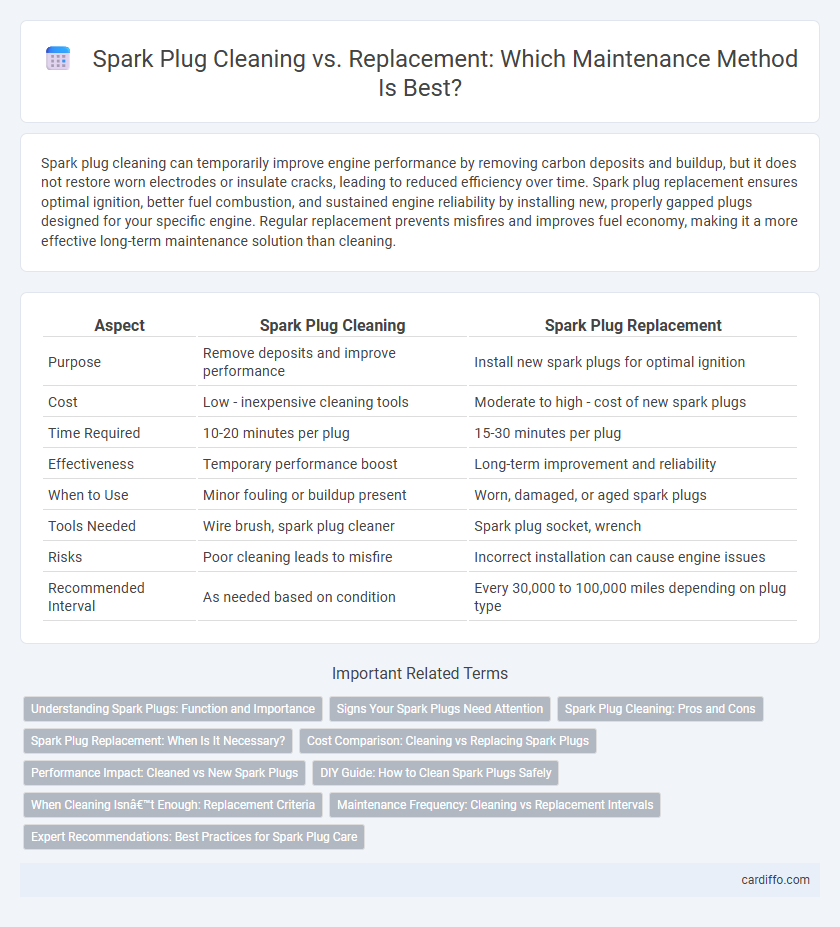Spark plug cleaning can temporarily improve engine performance by removing carbon deposits and buildup, but it does not restore worn electrodes or insulate cracks, leading to reduced efficiency over time. Spark plug replacement ensures optimal ignition, better fuel combustion, and sustained engine reliability by installing new, properly gapped plugs designed for your specific engine. Regular replacement prevents misfires and improves fuel economy, making it a more effective long-term maintenance solution than cleaning.
Table of Comparison
| Aspect | Spark Plug Cleaning | Spark Plug Replacement |
|---|---|---|
| Purpose | Remove deposits and improve performance | Install new spark plugs for optimal ignition |
| Cost | Low - inexpensive cleaning tools | Moderate to high - cost of new spark plugs |
| Time Required | 10-20 minutes per plug | 15-30 minutes per plug |
| Effectiveness | Temporary performance boost | Long-term improvement and reliability |
| When to Use | Minor fouling or buildup present | Worn, damaged, or aged spark plugs |
| Tools Needed | Wire brush, spark plug cleaner | Spark plug socket, wrench |
| Risks | Poor cleaning leads to misfire | Incorrect installation can cause engine issues |
| Recommended Interval | As needed based on condition | Every 30,000 to 100,000 miles depending on plug type |
Understanding Spark Plugs: Function and Importance
Spark plugs ignite the air-fuel mixture in an engine's combustion chamber, ensuring efficient performance and fuel economy. Over time, deposits and wear can degrade spark plug functionality, leading to misfires, reduced power, and increased emissions. Regular inspection, cleaning, or replacement of spark plugs maintains optimal engine operation and prevents costly repairs.
Signs Your Spark Plugs Need Attention
Worn or fouled spark plugs often cause engine misfires, reduced fuel efficiency, and difficulty starting the vehicle, signaling the need for maintenance. Excessive carbon buildup or damaged electrodes indicate that cleaning may be insufficient, requiring spark plug replacement. Regular inspection of spark plugs reveals cracks, corrosion, or burnt tips, key signs that immediate attention is necessary to ensure optimal engine performance.
Spark Plug Cleaning: Pros and Cons
Spark plug cleaning can restore electrode performance by removing carbon deposits, improving combustion efficiency and extending spark plug life at a lower cost than replacement. However, cleaning may not fully resolve issues caused by electrode wear or damage, leading to less reliable ignition and decreased engine performance over time. Regular inspection combined with cleaning can delay replacement but should be balanced against the risk of misfires or reduced fuel economy.
Spark Plug Replacement: When Is It Necessary?
Spark plug replacement becomes necessary when symptoms such as engine misfires, reduced fuel efficiency, or difficulty starting the vehicle persist despite cleaning efforts. Modern spark plugs typically require replacement every 30,000 to 100,000 miles, depending on the type and manufacturer specifications. Failure to replace worn or fouled spark plugs can lead to poor engine performance, increased emissions, and potential damage to ignition system components.
Cost Comparison: Cleaning vs Replacing Spark Plugs
Cleaning spark plugs typically costs between $10 to $30, making it a budget-friendly option compared to replacing spark plugs, which ranges from $50 to $150 depending on the vehicle and labor charges. While cleaning can extend the spark plug's life by removing carbon buildup and deposits, replacement ensures optimal engine performance and prevents misfires caused by worn electrodes or damaged insulators. Evaluating cost-effectiveness depends on the spark plug's condition, where consistent cleaning might save money short-term but timely replacement avoids potential engine damage and higher repairs over time.
Performance Impact: Cleaned vs New Spark Plugs
Cleaned spark plugs can temporarily restore engine performance by removing carbon deposits and improving electrode gaps, but they rarely match the efficiency of new spark plugs. New spark plugs deliver optimal ignition timing, fuel combustion, and consistent spark intensity, resulting in better fuel economy, smoother acceleration, and reduced emissions. Over time, worn spark plugs cause misfires and decreased power, making replacement essential for sustained engine performance and reliability.
DIY Guide: How to Clean Spark Plugs Safely
Cleaning spark plugs involves removing carbon deposits and inspecting the electrodes to restore optimal ignition performance, which can extend their lifespan and improve fuel efficiency. Use a wire brush or specialized spark plug cleaner, avoid abrasive sandpaper that can damage the ceramic insulator, and always wear protective gloves and eyewear for safety. Regularly check spark plug gaps with a feeler gauge to ensure proper spark and engine performance after cleaning.
When Cleaning Isn’t Enough: Replacement Criteria
Spark plug cleaning may restore performance for lightly fouled plugs, but replacement becomes necessary when signs of wear such as electrode erosion, cracked insulator, or persistent misfiring occur. Frequent exposure to harsh combustion conditions or deposits like carbon, oil, and fuel residue can render cleaning ineffective, necessitating new spark plugs to ensure optimal engine efficiency and fuel economy. Regular inspection intervals, typically every 30,000 to 50,000 miles, help determine when replacement is critical for maintaining reliable ignition and preventing engine damage.
Maintenance Frequency: Cleaning vs Replacement Intervals
Spark plug cleaning should be performed every 20,000 to 30,000 miles to remove carbon deposits and maintain optimal engine performance, whereas spark plug replacement is generally recommended every 60,000 to 100,000 miles depending on the vehicle manufacturer's specifications. Frequent inspections during oil changes can help identify whether cleaning is sufficient or a replacement is necessary, especially if signs of wear or electrode erosion appear. Adhering to these maintenance intervals ensures efficient combustion, improves fuel economy, and prevents engine misfires.
Expert Recommendations: Best Practices for Spark Plug Care
Experts recommend regular spark plug inspection every 30,000 miles to assess wear and carbon buildup. Cleaning involves using a wire brush or specialized cleaner to remove deposits, extending plug life when wear is minimal. Replacement is advised when electrodes show erosion, gaps exceed specifications, or performance issues persist, ensuring optimal engine efficiency and fuel economy.
Spark Plug Cleaning vs Spark Plug Replacement Infographic

 cardiffo.com
cardiffo.com